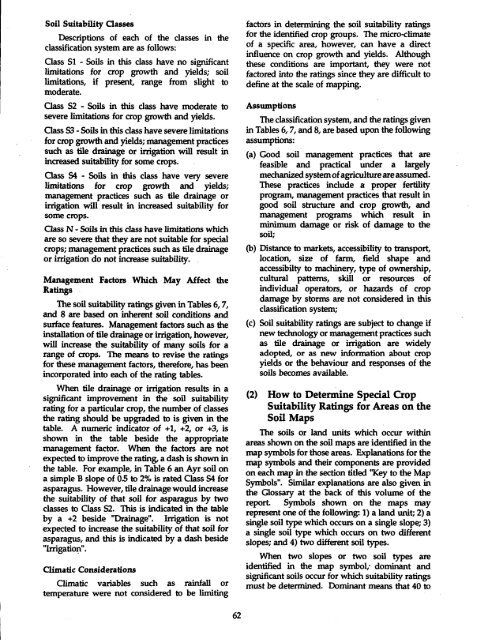The Soils of Elgin County - Agriculture and Agri-Food Canada
The Soils of Elgin County - Agriculture and Agri-Food Canada
The Soils of Elgin County - Agriculture and Agri-Food Canada
- No tags were found...
You also want an ePaper? Increase the reach of your titles
YUMPU automatically turns print PDFs into web optimized ePapers that Google loves.
Soil Suitability ClassesDescriptions <strong>of</strong> each <strong>of</strong> the classes in theclassification system are as follows :Class Sl - <strong>Soils</strong> in this class have no significantlimitations for crop growth <strong>and</strong> yields; soillimitations, if present, range from slight tomoderate.Class S2 - <strong>Soils</strong> in this class have moderate tosevere limitations for crop growth <strong>and</strong> yields .Class S3 - <strong>Soils</strong> in this class have severe limitationsfor crop growth <strong>and</strong> yields; management practicessuch as tile drainage or irrigation will result inincreased suitability for some crops .Class S4 - <strong>Soils</strong> in this class have very severelimitations for crop growth <strong>and</strong> yields;management practices such as tile drainage orirrigation will result in increased suitability forsome crops.Class N- <strong>Soils</strong> in this class have limitations whichare so severe that they are not suitable for specialcrops ; management practices such as tile drainageor irrigation do not increase suitability.Management Factors Which May AffectRatingsthe<strong>The</strong> soil suitability ratings given in Tables 6, 7,<strong>and</strong> 8 are based on inherent soil conditions <strong>and</strong>surface features. Management factors such as theinstallation <strong>of</strong> the drainage or irrigation, however,will increase the suitability <strong>of</strong> many soils for arange <strong>of</strong> crops . <strong>The</strong> means to revise the ratingsfor these management factors, therefore, has beenincorporated into each <strong>of</strong> the rating tables .When the drainage or irrigation results in asignificant improvement in the soil suitabilityrating for a particular crop, the number <strong>of</strong> classesthe rating should be upgraded to is given in thetable . A numeric indicator <strong>of</strong> +1, +2, or +3, isshown in the table beside the appropriatemanagement factor. When the factors are notexpected to improve the rating, a dash is shown inthe table . For example, in Table 6 an Ayr soil ona simple B slope <strong>of</strong> 05 to 2% is rated Class S4 forasparagus . However, tile drainage would increasethe suitability <strong>of</strong> that soil for asparagus by twoclasses to Class S2 . This is indicated in the tableby a +2 beside "Drainage" . Irrigation is notexpected to increase the suitability <strong>of</strong> that soil forasparagus, <strong>and</strong> this is indicated by a dash beside"Irrigation'.Climatic ConsiderationsClimatic variables such as rainfall ortemperature were not considered to be limitingfactors in determining the soil suitability ratingsfor the identified crop groups . <strong>The</strong> micro-climate<strong>of</strong> a specific area, however, can have a directinfluence on crop growth <strong>and</strong> yields . Althoughthese conditions are important, they were notfactored into the ratings since they are difficult todefine at the scale <strong>of</strong> mapping .Assumptions<strong>The</strong> classification system, <strong>and</strong> the ratings givenin Tables 6, 7, <strong>and</strong> 8, are based upon the followingassumptions:(a) Good soil management practices that arefeasible <strong>and</strong> practical under a largelymechanized system <strong>of</strong>agriculture areassumed.<strong>The</strong>se practices include a proper fertilityprogram, management practices that result ingood soil structure <strong>and</strong> crop growth, <strong>and</strong>management programs which result inminimum damage or risk <strong>of</strong> damage to thesoil;Distance to markets, accessibility to transport,location, size <strong>of</strong> farm, field shape <strong>and</strong>accessibilty to machinery, type <strong>of</strong> ownership,cultural patterns, skill or resources <strong>of</strong>individual operators, or hazards <strong>of</strong> cropdamage by storms are not considered in thisclassification system;(c) Soil suitability ratings are subject to change ifnew technology or management practices suchas tile drainage or irrigation are widelyadopted, or as new information about cropyields or the behaviour <strong>and</strong> responses <strong>of</strong> thesoils becomes available.(2) How to Determine Special CropSuitability Ratings for Areas on theSoil Maps<strong>The</strong> soils or l<strong>and</strong> units which occur withinareas shown on the soil maps are identified in themap symbols for those areas . Explanations for themap symbols <strong>and</strong> their components are providedon each map in the section titled "Key to the MapSymbols" . Similar explanations are also given inthe Glossary at the back <strong>of</strong> this volume <strong>of</strong> thereport. Symbols shown on the maps mayrepresent one <strong>of</strong> the following- 1) a l<strong>and</strong> unit; 2) asingle soil type which occurs on a single slope, 3)a single soil type which occurs on two differentslopes; <strong>and</strong> 4) two different soil types.When two slopes or two soil types areidentified in the map symbol, dominant <strong>and</strong>significant soils occur for which suitability ratingsmust be determined . Dominant means that 40 to62
















